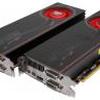Introduction
Radeon HD 7950 Boost - A little Bump 'n Grind Update
There has been an interesting yet rather sketchy move from AMD. At the time of writing this article it's just days before NVIDIA launch of the GeForce GTX 660 Ti. You can tell that AMD is a little uncomfortable with that release as less then a week before that NVIDIA launch we get an email if we wanted to test a new BIOS on the Radeon HD 7950. And sure why not, but what's different we asked ?
Well as you guys know AMD recently released the 7970 GHz edition, all of the sudden it came with turbo slash boost functionality. Basically depending on power load the GPU core clock frequency can clock up and down in a dynamic fashion. The function is not new and was introduced by NVIDIA on the series 600 cards, it's the very same thing.
In very simple wording, if your graphics card is allowed to use up-to 150 Watt the core frequency will be increased up-to a certain threshold until that 150 Watt margin has been reached, that means much more flexibility and where allowed, a little performance boost.
Now back to the Radeon HD 7950. You'll not be seeing GHz editions, but the this new update will introduce a boost/turbo function for the Radeon HD 7950.
Now, the 28nm Tahiti PRO with its 1792 shader processors based card typically is clocked at a 800 MHz reference base clock. On the new update two things change, the boost functionality itself and the core is now allowed to boost to 925 MHz. That means that under the right conditions the card gets a bump of 5 to 10% performance according out measurements.
First and foremost, this feature is intended for newly released SKUs. We would however not be surprised to see AIC partners release new BIOSes to make the cards compatible as really all it takes is a firmware flash.

Obviously that screams for a quick update in performance differences, so head on over to the next pages where we'll show you a few benchmarks demonstrating what the new boost functionality means and does.

